Add your promotional text...
Unit - I : Introduction to Microcontrollers
CA – 153 – T : Introduction to Microcontrollers First Year of B. Sc. (Computer Applications) - (2024 Course)
AICTE MICROCONTROLLER
Asst.Prof. G. A. Darandale


Introduction to Microcontroller and Microprocessor
A microprocessor is a central processing unit (CPU) on a single chip, designed primarily for general-purpose computing tasks. It requires external components such as RAM, ROM, and input/output (I/O) interfaces to function. Microprocessors are the heart of personal computers, laptops, and servers, excelling in high-performance, complex, and multitasking environments.
A microcontroller, by contrast, is a compact system that integrates a CPU, memory (RAM and ROM/Flash), and peripherals (such as timers, ADCs, and I/O ports) on a single chip. Microcontrollers are designed for dedicated, real-time control applications, such as embedded systems in appliances, vehicles, and IoT devices. They are optimized for low power consumption, cost-effectiveness, and standalone operation without the need for complex external hardware or operating systems.
Difference Between Microcontroller and Microprocessor
1. Basic Definition:
Microprocessor: A central processing unit (CPU) on a single chip, mainly used for general-purpose processing tasks.
Microcontroller: A compact integrated circuit containing a CPU, memory, and I/O peripherals, designed for specific control applications.
2. Components:
Microprocessor: Contains only the CPU; external RAM, ROM, and I/O ports are needed for operation.
Microcontroller: Contains CPU, RAM, ROM (or Flash), timers, and I/O ports all on one chip.
3. System Complexity:
Microprocessor: Requires a complex circuit board with many external components.
Microcontroller: Requires a simple, compact circuit due to built-in components.
4. Application:
Microprocessor: Used in computers, laptops, and systems requiring high processing power and multitasking.
Microcontroller: Used in embedded systems like washing machines, microwave ovens, and IoT devices for dedicated tasks.
5. Architecture:
Microprocessor: Usually based on Von Neumann architecture (shared program and data memory).
Microcontroller: Usually based on Harvard architecture (separate program and data memory).
6. Memory:
Microprocessor: Needs external memory (RAM and ROM) for program and data storage.
Microcontroller: Has internal memory (RAM and ROM/Flash) for program and data storage.
7. Input/Output (I/O):
Microprocessor: Needs external I/O ports.
Microcontroller: Has built-in I/O ports.
8. Power Consumption:
Microprocessor: Higher power consumption due to external components.
Microcontroller: Lower power consumption, often includes power-saving modes.
9. Cost:
Microprocessor: More expensive overall (chip plus supporting components).
Microcontroller: More cost-effective for embedded applications.
10. Performance:
Microprocessor: High performance, suitable for complex and multitasking operations.
Microcontroller: Optimized for real-time, dedicated control tasks.
11. Programming:
Microprocessor: Fewer registers, programming can be more complex.
Microcontroller: More registers, making programming simpler for control tasks.
12. Suitability:
Microprocessor: Best for applications needing high computational power and flexibility.
Microcontroller: Best for applications needing control, automation, and energy efficiency.
Microcontrollers use on-chip embedded Flash for program storage, leading to faster startup and execution, but with limited memory (usually up to 2 MB).
Microprocessors rely on external memory (DRAM, Flash), supporting much larger capacities (hundreds of MB to several GB), suitable for complex applications and operating systems.
Microcontrollers are ideal for cost-sensitive, power-efficient, and space-constrained applications, while microprocessors are favored for high-performance, flexible computing needs.
Classification of Microcontrollers:
Microcontrollers can be classified based on several criteria:
1. By Architecture:
Harvard Architecture: Separate memory and buses for instructions and data, allowing simultaneous access and faster execution. Common in modern MCUs (e.g., ARM Cortex-M, PIC).
Von Neumann Architecture: Shared memory and bus for instructions and data, simpler but potentially slower due to bus contention. Less common in MCUs.
2. By Instruction Set:
RISC (Reduced Instruction Set Computer): Fewer, simpler instructions, often executed in a single cycle. Examples: ARM Cortex-M, PIC16F84.
CISC (Complex Instruction Set Computer): More complex instructions, variable execution time. Examples: Some older Intel MCUs.
3. By Bit Width:
8-bit MCUs: Simple, cost-effective, used in basic control tasks (e.g., 8051, PIC16).
16-bit MCUs: Intermediate performance (e.g., MSP430).
32-bit MCUs: High performance, advanced features, widely used in modern embedded systems (e.g., ARM Cortex-M series, ESP32).
4. By Memory Configuration:
Embedded Memory Microcontrollers: All memory and peripherals are on the chip (most modern MCUs).
External Memory Microcontrollers: Require external memory chips for program/data storage (less common today).
5. By Application Domain:
General Purpose: Used in a wide range of applications (e.g., Arduino, STM32).
Application-Specific: Tailored for automotive, industrial, or communication tasks.
Examples of Microcontroller Families:
ARM Cortex-M Series: STM32, NXP Kinetis, Atmel SAM.
PIC Series: PIC16, PIC32.
AVR Series: ATmega, ATtiny.
ESP Series: ESP8266, ESP32 (IoT-focused).
Applications of Microcontrollers:
Microcontrollers are ubiquitous in modern electronics, powering a vast array of devices and systems:
Industrial Automation: Control of robotic arms, conveyor belts, process monitoring, and factory automation systems.
Automotive: Engine control units (ECUs), transmission, anti-lock brakes, airbag deployment, infotainment, and climate control.
Home Appliances: Washing machines, microwave ovens, refrigerators, air conditioners, and smart home devices.
Consumer Electronics: Smartphones, tablets, digital cameras, smartwatches, and toys.
Medical Devices: Heart rate monitors, blood pressure monitors, insulin pumps, portable diagnostic tools.
Military and Aerospace: Guidance systems, drones, secure communications, and surveillance equipment.
IoT and Smart Devices: Smart meters, wearable fitness trackers, home automation controllers, environmental sensors.
Research and Prototyping: Widely used in educational and hobbyist projects (e.g., Arduino, Raspberry Pi Pico).
Example Projects:
IoT energy meters, anti-theft systems, health monitoring devices, solar trackers, smart vending machines, automated irrigation systems, and many more.
